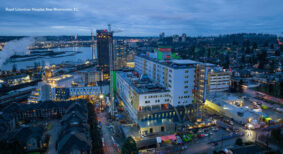In Canada, and in British Columbia specifically, communities are becoming more actively involved in dealing with environmental concerns. Many terms such as renewable energy, sustainability, global warming and greenhouse gas emissions are becoming familiar to the public. Technological solutions such as district energy are proving effective in reducing the carbon footprint of communities on the planet.
More than 50 per cent of Canadians’ energy consumption is for heating and cooling. Effectively utilizing thermal heated energy allows communities to achieve higher energy efficiency and develop more cost-effective infrastructure.
District energy enables communities to benefit from a diverse range of energy sources, including renewable ones. A community or neighbourhood can centralize energy generating equipment in one location. This is often referred to as the central energy centre. In other words, all end users, whether a school, community centre or even a residence, will have neither a furnace nor air conditioning equipment. Instead, the central energy centre becomes the heat source and/or heat sink for the entire community.
The University of British Columbia (UBC) is a great local example of how this can work. It has one of the largest and oldest (since 1926) district energy systems in the province. The system is currently undergoing a steam to hot water conversion. This huge project will upgrade all heating infrastructure such as distribution piping, boilers and heat exchangers throughout the university. The five-year phased construction will be completed in 2015. It will include more than 14 kilometres of hot water distribution piping and approximately 130 energy transfer stations that transfer heat from the hot water loop to individual building heating loops. A new Campus Energy Centre will also be constructed in early 2015. In addition, a bioenergy research and demonstration facility, which hosts a biomass combined heat and power plant, is currently in the final commissioning stages.
This new and improved district energy system will:
- Provide a more energy-efficient campus;
- Meet the challenging greenhouse gas reduction targets that UBC set for 2015;
- Enable fuel diversity;
- Enable capturing waste heat from a nearby research facility; and
- Enable the university to develop a more reliable and efficient combined heat and power facility.
The main mechanical components of the system include the hot water distribution piping, energy transfer stations and the Campus Energy Centre. The distribution piping system is Danish-manufactured Logstor pre-insulated piping, which is a thin-walled, pre-insulated pipe with a plastic jacket. This is a cost-effective and reliable system that is capable of detecting leaks.
The energy transfer stations will provide separation between the hot water circulated in the new district energy system through the Campus Energy Centre and the existing piping within the aging buildings. All energy transfer stations will be controlled automatically to realize the maximum system efficiency.
In addition to the advanced mechanical components of the system, innovation lies in the ability for fuel flexibility that comes with the district energy system through the combined heat and power plant. The biomass plant will produce three Megawatts of thermal energy and two Megawatts of clean electricity. The thermal energy produced by the plant will provide heat to the district energy system.
UBC’s district energy steam to hot water conversion is one of four projects in the “campus as a living laboratory” initiative designed to help the campus meet its greenhouse gas reduction target of 33 per cent by 2015. Upon completion, the conversion project alone will reduce campus greenhouse gases by 22 per cent. The campus will benefit from the replacement of aging and end of life steam piping, and a power plant that will provide an annual operational cost-saving of approximately $4 million through reduced natural gas consumption. This will reduce the university’s carbon tax and maintenance costs because of the lower operating pressure and temperature.
Phases 1 through 3 of the project saw the installation of more than 5 kilometres of underground piping and 12 energy transfer stations. The university was not only successful in decommissioning the steam line feeding the southwest quadrant of the university in January 2012, but it is already realizing significant operating savings.
UBC’s hot water district energy system provides a valuable example of the possible cost savings, fuel flexibility and renewable energy opportunities that can be realized through implementing a district energy system. It is a proven technology that can help keep British Columbia beautiful.
Ayman Fahmy, P.Eng., is senior thermal power engineer at Kerr Wood Leidal. He has more than 10 years experience in the district energy field. Elizabeth Mosier is a project engineer at the consulting engineering firm, with more than two years experience in design of district energy systems distribution piping.










